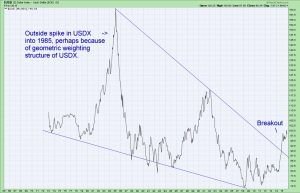Geometric weighting of US dollar indexes including USDX and potential for outside rally.
This was originally my reply to a post from Graddhy from 3 Jan 2015:
http://goldtadise.com/?p=359005
I posted four replies covering what this Euro crash might do the the US dollar index (USDX) and then going on to muse on the geometric weighted nature of the USDX calculation and, whether that construction of the index caused the huge USDX spike above 160 in 1985 and what would happen to it if the Euro (or any other currency included in the USDX weightings) really crashed and suffered a hyperinflation. Here they are:
DaveintheUK January 5, 2016 – 4:34 am at 4:34 am
From the above post by Graddhy with the charts showing possibilities of a crash in the Euro, a ‘halving’ in the Euro (from 105 to 55 approx) would mean the dollar index would go up by about the square root of 2, which is about 1.4x (Euro is 57.6% of the USDX denominator but let’s say 50% roughly).
That would take the USDX from 100 to 140 even if the dollar didn’t move up against any other currency (pound, yen,etc). Just round figures.
Using a neckline on the Euro of 105, target of 55, USDX at 99 today and 57.6% as Euro weight in basket gives a USDX target of 143.7.
It is very unlikely that the Euro would fall like this without yen, pound, etc also taking a tumble, surely.
So, if these above patterns work out, then the giant falling wedge on the dollar index since 1985 might reach its 160 target too?
DaveintheUK January 5, 2016 – 4:40 am
Also, Graddhy’s Euro chart seems to indicate the possibility of a quick Euro downmove to the target, i.e. in this current US dollar bull market cycle, maybe even this year?
The current USDX bull cycle is arguably nearly 8 years old (since the low around March 2008 at around 70) so it needs to get a good move in fairly quickly to be in line with previous dollar bull and bear cycles that lasted around 8 years or thereabouts.
However, there is the possibility that with deflationists winning hands down, the US dollar might not obey the rules of the past 45 years and could just go on a rocket ride to undo its 45 year bear market of lower lows. Perhaps?
What would that mean for gold, dare I venture to ask?
DaveintheUK January 5, 2016 – 4:57 am
I noticed on my brief studies of the various US dollar indexes that the USDX is calculated on a geometric average of rates against other currencies.
That is convenient if the US dollar is weak because it prevents any excessive dollar weakness against one of the other currencies from having much of a negative effect on the USDX figure.
However, if one or more of the other currencies gets very weak, these are on the denominator and will have an outsized effect on the USD dollar index to the upside, especially if the USDX gets much above 100, let’s say to around 120-130+.
I believe this is what happened in 1983-1985, when there was a seemingly insane upspike in the USDX to 160+. Some weakness in other currency areas had an outsize positive effect on the USDX because of its geometric weighting on the denominator.
If ANY of these other currencies has a hyperinflation and tends to zero value, the USDX can go to infinity, which is not in my view a very good index because all the remaining currencies could still be stable. Let’s say if Yen goes to 0, USDX goes to infinity, even if Euro is stable.
We could have a sweepstakes on which currency will have a hyperinflation first. A practically worthless but decorative ounce of gold to the winner?
It’s quite interesting.
…
DaveintheUK January 7, 2016 – 9:28 am at 9:28 am
For descriptions of the make-up of the dollar indices, I downloaded a few pdf files from somewhere.
Here is one from the horse’s mouth, so to speak!
http://www.federalreserve.gov/pubs/bulletin/2005/winter05_index.pdf
Of course there is gobbledegook on there but it says on page 1:
“exchange rate indexes that are geometrically weighted averages of bilateral exchange rates.”
It has a giant PI symbol rather than a sigma symbol which indicated a geometric average rather than an arithmetic one (calculated from a product of multiplications rather than a sum of additions for any non-technical people). However this document is for the Fed indexes like the broad trade weighted dollar index, etc. – but this principle also applies to the USDX, I am sure.
This page gives a formula showing the weightings:
http://www.babypips.com/school/undergraduate/sophomore-year/dollar-index/how-to-read-the-dollar-index.html
and it is plain to see that the USDX is a geometric average:
“USDX = 50.14348112 × EUR/USD^(-0.576) × USD/JPY^(0.136) × GBP/USD^(-0.119) × USD/CAD^(0.091) × USD/SEK^(0.042) × USD/CHF^(0.036)
Wikipedia also says so:
https://en.wikipedia.org/wiki/U.S._Dollar_Index
Same formula here:
https://www.theice.com/publicdocs/futures_us/ICE_Dollar_Index_FAQ.pdf
The weightings are as follows – also given on Kitco.com:
“CURRENCY WEIGHT
Euro (EUR) 0.576 (Kitco would say 57.6%, same thing)
Japanese Yen (JPY) 0.136
British Pound (GBP) 0.119
Canadian Dollar (CAD) 0.091
Swedish Krona (SEK) 0.042
Swiss Franc (CHF) 0.036”
You get good info but diminishing returns by looking at these pages…
here:
https://www.rjobrien.co.uk/documents/shared/currency/us_dollar_index_futures_and_options_small.pdf
here:
http://www.elitetrader.com/et/index.php?threads/calculating-the-dollar-index-by-hand.74633/
and here:
https://www.theice.com/publicdocs/ICE_USDX_Brochure.pdf
except this last one compares the USDX with the Fed’s major currency index and says they are pretty similar.
Also:
https://research.stlouisfed.org/fred2/categories/105
going to
https://research.stlouisfed.org/fred2/series/TWEXB
Trade Weighted U.S. Dollar Index: Broad
and
https://research.stlouisfed.org/fred2/series/DTWEXM
Trade Weighted U.S. Dollar Index: Major Currencies
I have tried to find the formula written like an old one in a science class, with you know something over something else with the terms all laid out nicely but I can’t find one.

DAve, thanks very much for tracking down this data….